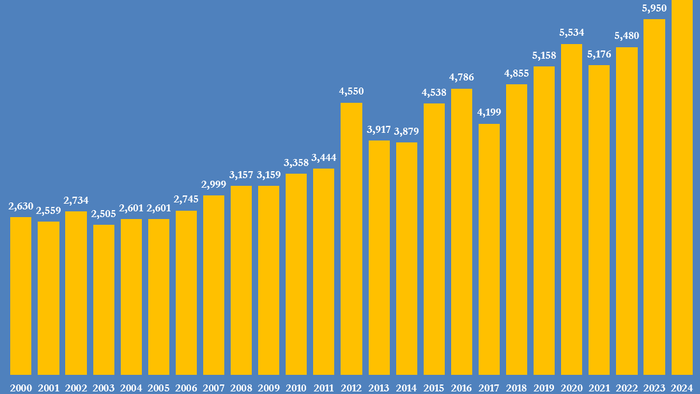The United States has witnessed a significant rise in gas-fired electricity generation, primarily driven by exceptionally low natural gas prices. In the first half of 2024, electricity generation reached a staggering 2,069 billion kilowatt-hours (kWh), a 5% increase over the same period in 2023, accounting for an additional 98 billion kWh of production. This surge in output primarily came from gas-fired units, which contributed 43 billion kWh to the total, alongside solar and wind sources. Gas-fired generation reached an all-time high of 857 billion kWh, representing 41% of the total energy produced, marking a record for the U.S. energy sector. The increase in gas generation resulted in a consumption of 6,264 billion cubic feet (bcf) of natural gas, reflecting a substantial rise of 314 bcf from the previous year, indicative of the growing reliance on gas for electricity generation.
The drastic reduction in gas prices has played a pivotal role in this generation boom, with prices hitting their lowest level in more than five decades, particularly in March 2024 when adjusted for inflation. As a result, gas-fired power plants have been able to operate more frequently, including certain less efficient units that typically ramp up during peak demand periods. The competitive landscape shifted significantly during this timeframe as natural gas costs dipped below those of coal on an energy basis, a historic first since 1975, allowing gas generators to further penetrate the market. Statistically, gas generation units require only 7,740 British thermal units (BTUs) to produce a kilowatt-hour of electricity, compared to 10,689 BTUs for coal. The economic dynamics favored gas due to its price advantage of 10-20%, exacerbating the decline in coal usage as gas-generated electricity became more viable and cost-effective.
In the third quarter of 2024, the trend of escalating gas generation continued, particularly as demand peaked during the summer months. Gas units in the Lower 48 states generated a remarkable 540 billion kWh, an increase from 525 billion kWh in the same period of 2023. The growth of gas-fired generation occurred in a context where overall electricity production remained relatively flat year-on-year, with the additional output primarily coming at the expense of coal. The coal sector saw a decline in generation from 221 billion kWh to 201 billion kWh. This ongoing transition shows a significant shift in the energy supply landscape, wherein gas emerges as the dominant source of new electricity generation.
Moreover, the increase in gas-fired generation has caused notable adjustments in fuel inventories and production capacities. The summer quarter saw gas stocks rise by only 430 bcf, the smallest seasonal increase since at least 2010, indicating a tightening of supply amidst surging consumption. By the end of September, working gas stocks were just 185 bcf above the ten-year seasonal average, a substantial reduction from earlier surpluses. This decline in inventory levels suggests that the gas market is beginning to normalize following a mild winter that had left excess supplies at the start of 2024. This reduction in inventory not only signals increased gas consumption but also emphasizes the waning of previously abundant supply, which has implications for future pricing and availability.
The interplay of rising gas generation and declining inventories has begun to influence gas prices, which witnessed a gradual uptick as the surplus diminished. By October 2024, front-month futures prices averaged $2.80 per million BTUs, a noticeable increase from the lows of $1.75 seen in March. While prices are still below the inflation-adjusted historical averages, the incremental rise showcases the shifting dynamics within the energy market. Notably, these changes could have varying impacts, particularly as prices remain close to coal costs, which suggests that gas generation may continue to lead, as long as prices do not exceed $3.00-3.25 on a sustained basis. If gas prices rise too high, it may lead to a resurgence in coal’s competitiveness, thereby altering the current trajectories in electricity generation.
Looking ahead, the future of gas-fired generation depends heavily on price stability and market conditions. While the potential for record-high gas generation exists, the key determining factor will be whether future prices can remain lower than or competitive with coal and other energy sources. If prices stabilize at elevated levels, the energy market may experience a shift back toward coal or other alternatives as operators seek the best financial returns. Thus, the current state of the natural gas market presents both opportunities and challenges for electricity providers, regulators, and consumers, all of whom will be closely monitoring developments in pricing and energy sourcing as the year progresses. In summary, the shift towards gas-fired generation reflects broader transitions in U.S. energy consumption, offering a glimpse into an evolving energy future driven by economics, supply-demand balances, and increasing reliance on cleaner sources of power.

